NEW MOELWYN TUNNEL

It will be 50 years this September since construction of the New Moelwyn Tunnel – a vital part of the Ffestiniog Railway’s Deviation project and extension to Blaenau Ffestiniog – got under way. This is the inside story... literally.
WORDS: JOHN DOBSON AND BOB LE MARCHANT
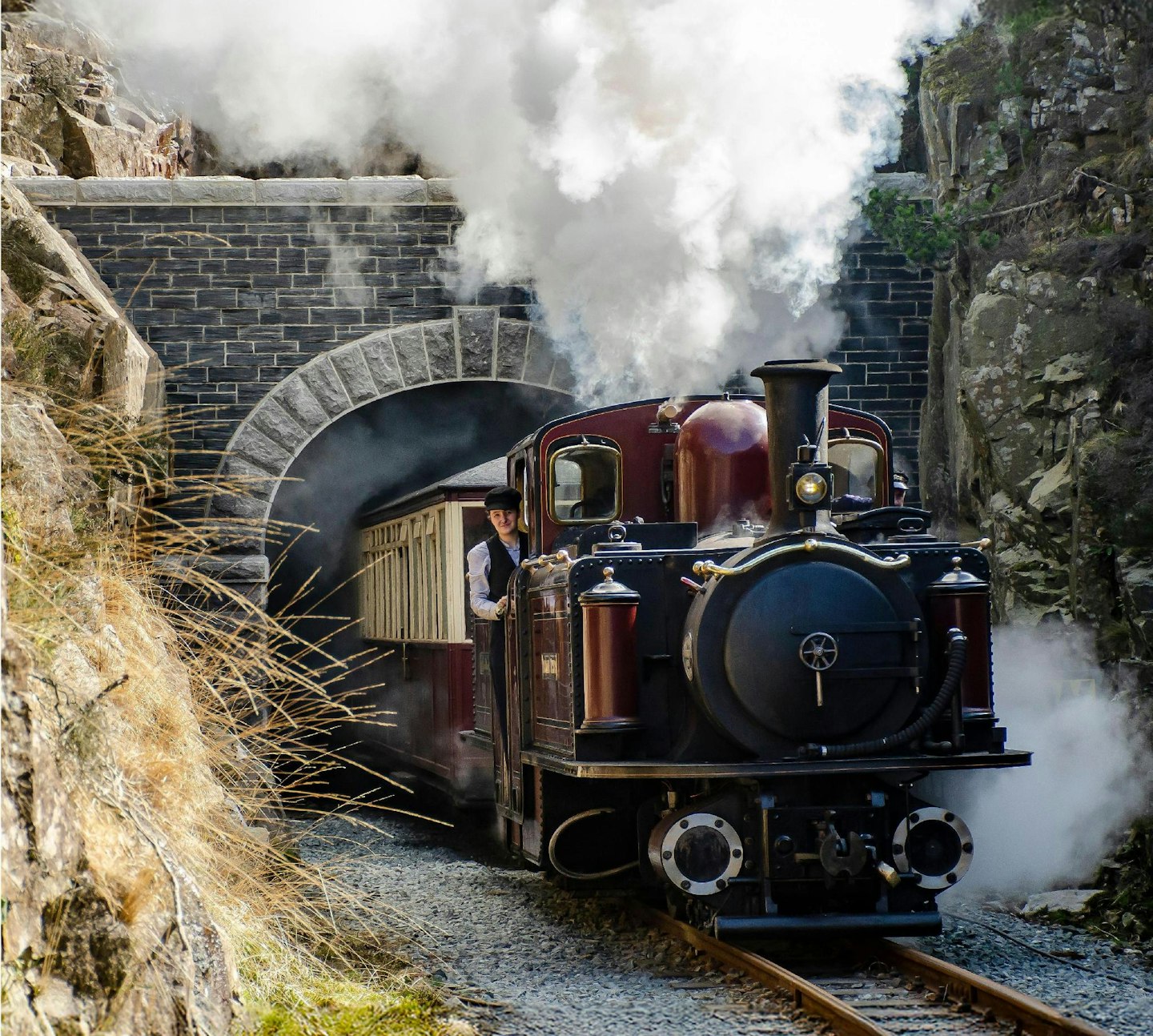
Double Fairlie Merddin Emrys emerges from the newly completed north portal of the new Moelwyn Tunnel on March 29 2019. CHRIS PARRY/FFWHR
Although it was always the firm belief of many early Ffestiniog Railway volunteers that the railway would be rebuilt back to Blaenau Ffestiniog, the difficulties that stood in the way of achieving this were considerable. Not only was it necessary to reconstruct the entire line from Porthmadog to Dduallt and then build around two-and-a-half miles of new formation around the lake created by the Tanygrisiau Pumped Storage Scheme, including the now-famous spiral, but a tunnel of considerable length was also required through a spur of the Moelwyn mountains. This was arguably a saving grace, as the old Moelwyn tunnel had a very restrictive bore, just eight feet wide and 9ft 6in high, which severely limited the loading gauge and would have placed major constraints on the motive power and rolling stock able to travel north of Dduallt.
Nevertheless, work on the Deviation commenced with the cutting of the first sod in January 1965. Given sufficient time (one estimate was 35 years!) much of the open-air navvying required to create the new formation could be done using unskilled volunteer labour, but boring the tunnel was a job for professionals. Fortunately, as has often happened on the FR since 1955, the right people appeared at the right time in the form of three Cornish mining engineers – Peter Hughes, Robin Daniel, and Bob Le Marchant. The following description of how the work was carried out was written by Bob Le Marchant in 2020 – 45 years after tunnelling began.
Mining expertise
A few statistics will illustrate the magnitude of this task. The tunnel as completed is 3.5 metres wide (11½ft), 4 metres tall (13ft), and 271 metres (888ft) long. The rock through which the tunnel was bored is syenite, a hard material which is granite with one of its normal constituent minerals missing, interspersed with micro-granite. There are no boundaries between the two types of rock and the whole ridge through which the tunnel runs is intersected with faults, running in all directions, and generally water-filled. The average block size is just under a metre square.
The dimensions of the finished tunnel required 3,794 cubic metres of rock to be blasted, which produced 10,434 tons of broken rock, or about 12,000 skip-loads, all of it needing to be loaded and taken away. Each day, 42 holes were drilled into the tunnel face, each hole being eight feet (2.4 metres) long, and 32mm in diameter. 223 rounds had been blasted by the end of the job, and we later came back to make the tunnel higher. 5,608 holes were filled with gelignite, making a total of 6,400 holes drilled including those required for the rock bolts. 5,608 electric detonators were used and 14,640lbs of explosive. Explosives came from the ICI Cookes works in Penrhyndeudraeth and were kept locked in a steel store on the top of the hill above the tunnel.
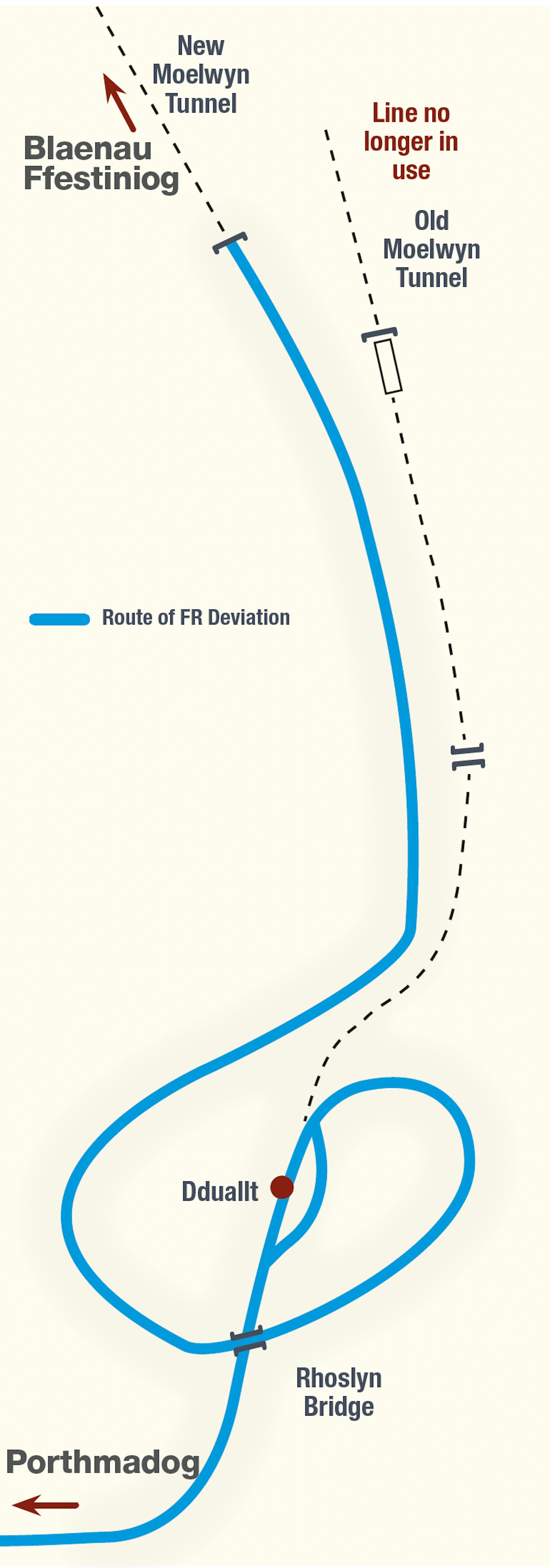
When, out of curiosity, I came to look at the Deviation project for the first time, construction of the Dduallt spiral was fully under way, and I met a gruff, but friendly, chap, soon to be known to everyone as Bunny Lewis. He informed me that they had originally had a half-promise from the Army that they would do the tunnel job, using their Gibraltar sappers, if and when the new formation reached the site. However, when pressed, they admitted they had no one capable of doing the job. Contractors had been approached, but the lowest bid, by McAlpine’s, was £120,000 – far beyond any reasonable FR budget at that time. Being on leave from my career as a gold miner in South Africa, I suggested the project wasn’t too difficult, and that I could advise them through it.
To provide some background to my expertise, and that of Peter and Robin, I first met Robin during a year spent at the South Crofty tin mine in Cornwall. I was the geologist’s underground ‘gofer’. On measuring days, I joined the sampling gang, and found Robin 70 feet up an inclined raise, or connection, between levels – accessible via a chain climbed at 80º. He was drilling upwards, standing on a platform of planks placed on four steel pins. He was then one of the top miners in the mine. Peter was also an experienced miner.
On graduating from the Camborne School of Mines, I’d gone to work for the Goldfields group of mines in South Africa, where life was extreme in every way. I was expected to gain experience in all the necessary trades the hard way, and stayed doing each job until I exceeded the mine average (metres drilled/blasted, or tons loaded) before being moved on to the next. The mine was 11,700 feet deep with a rock temperature of 160°F (71°C), and each of the two shifts consisted of 4,000 men. The mine language was Fanakalo, and I was given an intensive two weeks to learn it. At the depth this mine reached, square tunnels eventually become circular due to intense rock pressure, and stopes – the actual mineral excavations – closed up completely within a year or so, despite a 40% filling of timber. I became experienced in blasting curved tunnels, vertical and inclined tunnels, junctions, etcetera, so the business of blasting a straight tunnel through the Moelwyns presented no difficulties.
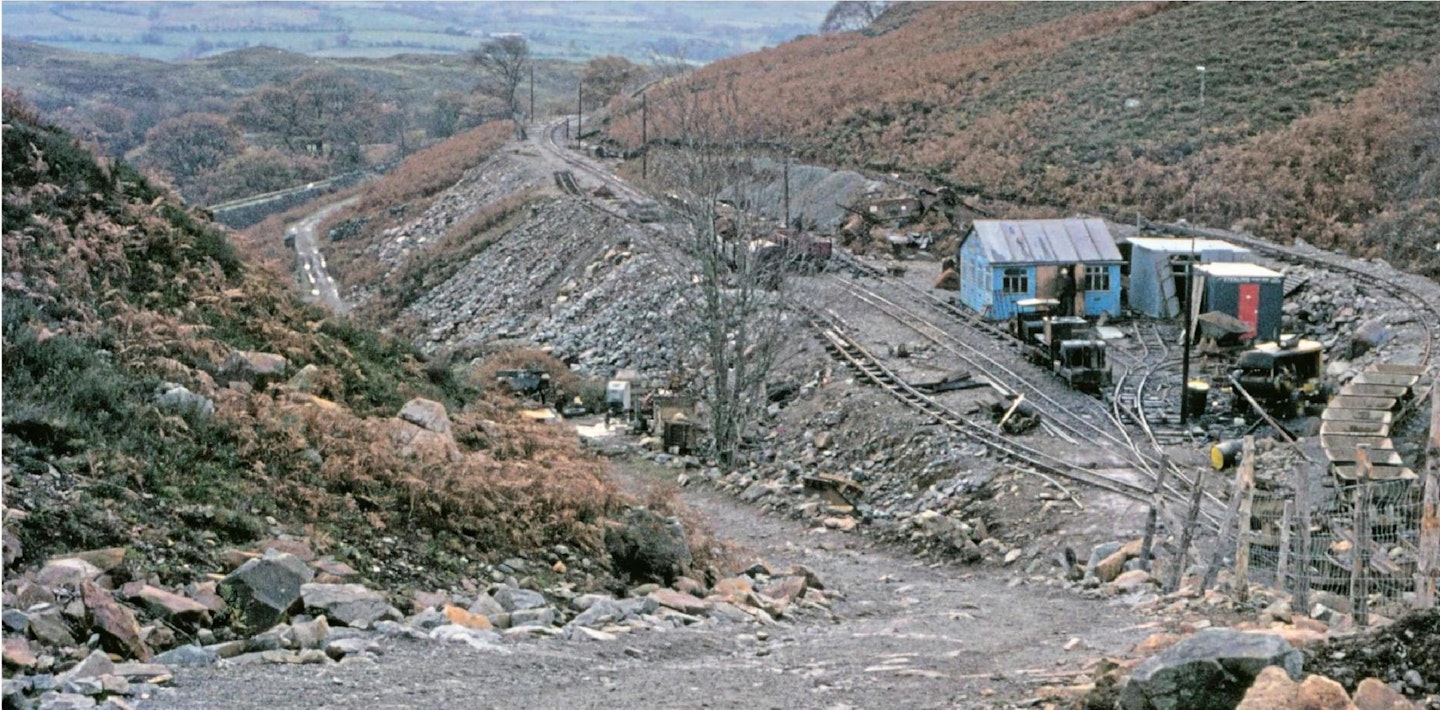
This view looking south from the southern approach cutting shows the stone processing site and the somewhat basic facilities available to the tunnel builders. The stone embankment that carried the original FR towards the Old Moelwyn Tunnel is visible on the left. PETER JOHNSON COLLECTION
Fire in the hole!
I began to communicate with the Deviation Project Engineer, Mike Schumann, when I returned to South Africa, telling him the method he should use, and the equipment he needed to get ready on site. He was also talking to Peter and Robin along the same lines. Unbeknownst to me, the company was already having problems with blasting the approach cuttings – not a job I would have liked, the ground being a mixture of bog and fractured rock. As time went on, Mike suggested that I came and joined the other two miners and did the tunnel job in person. After working a six-day week in South Africa for three years, with very few holidays, North Wales looked appealing.
We all met up on site for the first time at the beginning of September 1975, when we unpacked three new Atlas Copco compressed-air-driven drills. The site had been set up with a big 600 cubic ft per minute compressor, and a semi-mobile screening plant. This last item was expected to be useful for screening the broken rock into ballast for the railway. It was never a real success, and the track gangs struggled with the resultant oversize ballast, which couldn’t be properly tamped. A number of rough sidings contained 35 one-ton V-skips and an old two-ton battery-electric mine locomotive. A brand new, compressed-air-driven Atlas Copco rock loader had also been obtained.
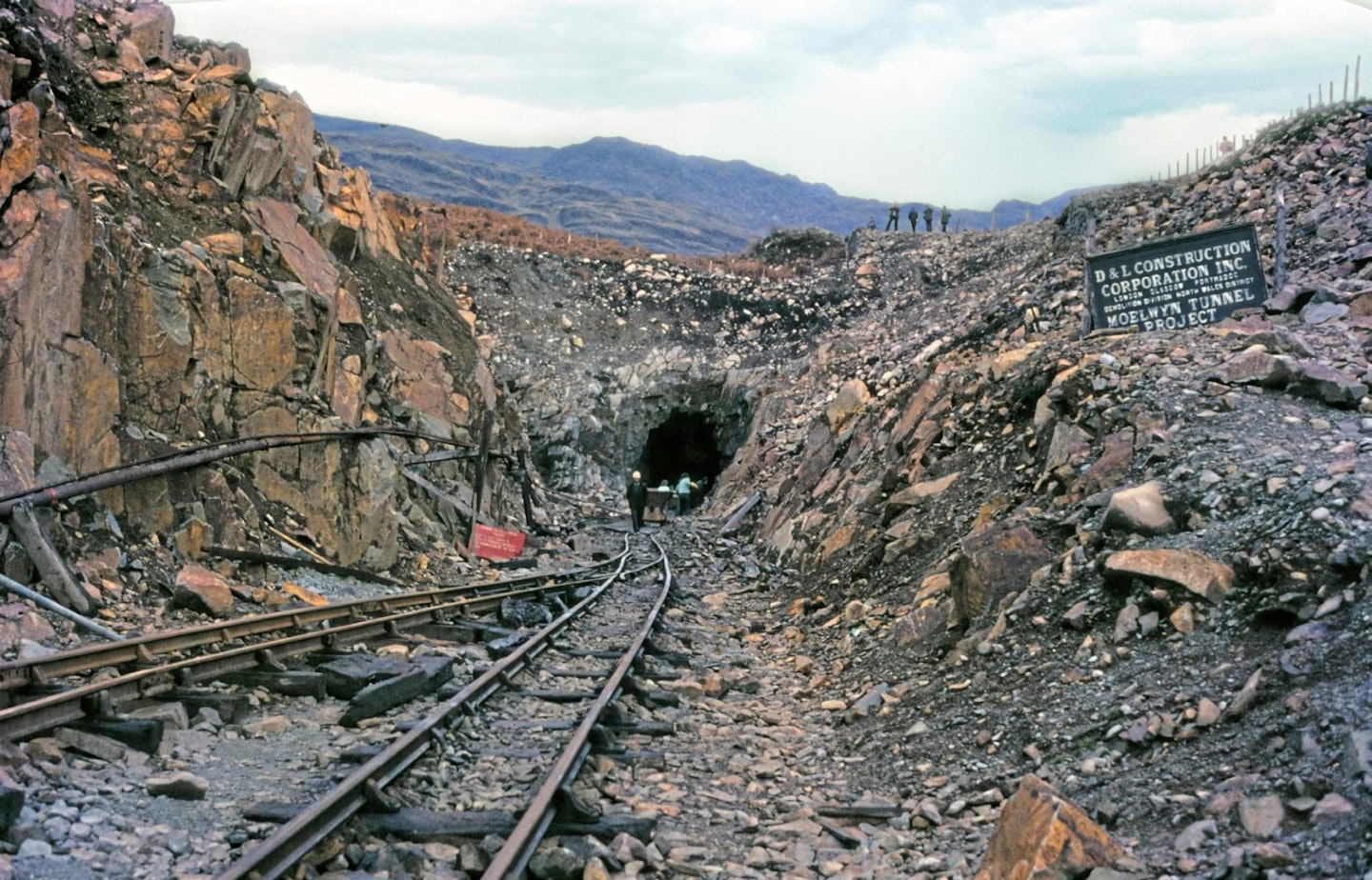
A fascinating early view of the Moelwyn Tunnel construction site during the mid-1970s, showing how the tunnel was literally blasted through the landscape. PETER JOHNSON
Our first job was to decide on the drilling pattern. The ‘cut’, or the first holes to explode, is of vital importance to any tunnel blasting. Different rock types require quite different combinations of holes. They have to be arranged to explode to a free face. In our case, nine holes were drilled within a nine-inch square, straight in, and parallel. This is where skill and experience come in. The central hole is left uncharged, and is the free face into which the other eight fracture. If these central holes fail in some way, the rest of the blasted face will be a mess, resulting in less advance, no flat face next day, and possibly raw explosive left to be found accidentally.
The first nine holes were drilled, and Robin and Pete left to go home to Cornwall. This left me to load and blast next day, witnessed by FR Directors John Routley and Bill Broadbent, General Manager Allan Garraway (always a Deviation sceptic) and Mike Schumann. A Beethoven exploder requires a vigorous winding of its generator handle, until the capacitor inside lights up, before pressing the firing button. I’d been using lit fuses in South Africa. With the Great and Good watching from a distance, I wound the handle, pressed the button, and nothing happened. This was a bad moment, with so much at stake. I saw Garraway turn away in disgust. I tried again and a roar resulted.
Due to the poor nature of the entrance, we cut a smaller hole to start with, and once inside opened it up to the full dimensions. This proved to be a problem, as the roof was now too high to work the drills without a platform, which had to be pushed inside every day. We decided to speed things up by returning to full width, but only eight feet high. This enabled us to achieve a full round each day – mucking out the broken rock in the mornings, drilling and blasting in the afternoon, the fumes dispersing at night. Thus, our daily advance was either eight feet, or nothing. This was a 12-hour day, if nothing went wrong.
“I wound the handle, pressed the button, and nothing happened. This was a bad moment”
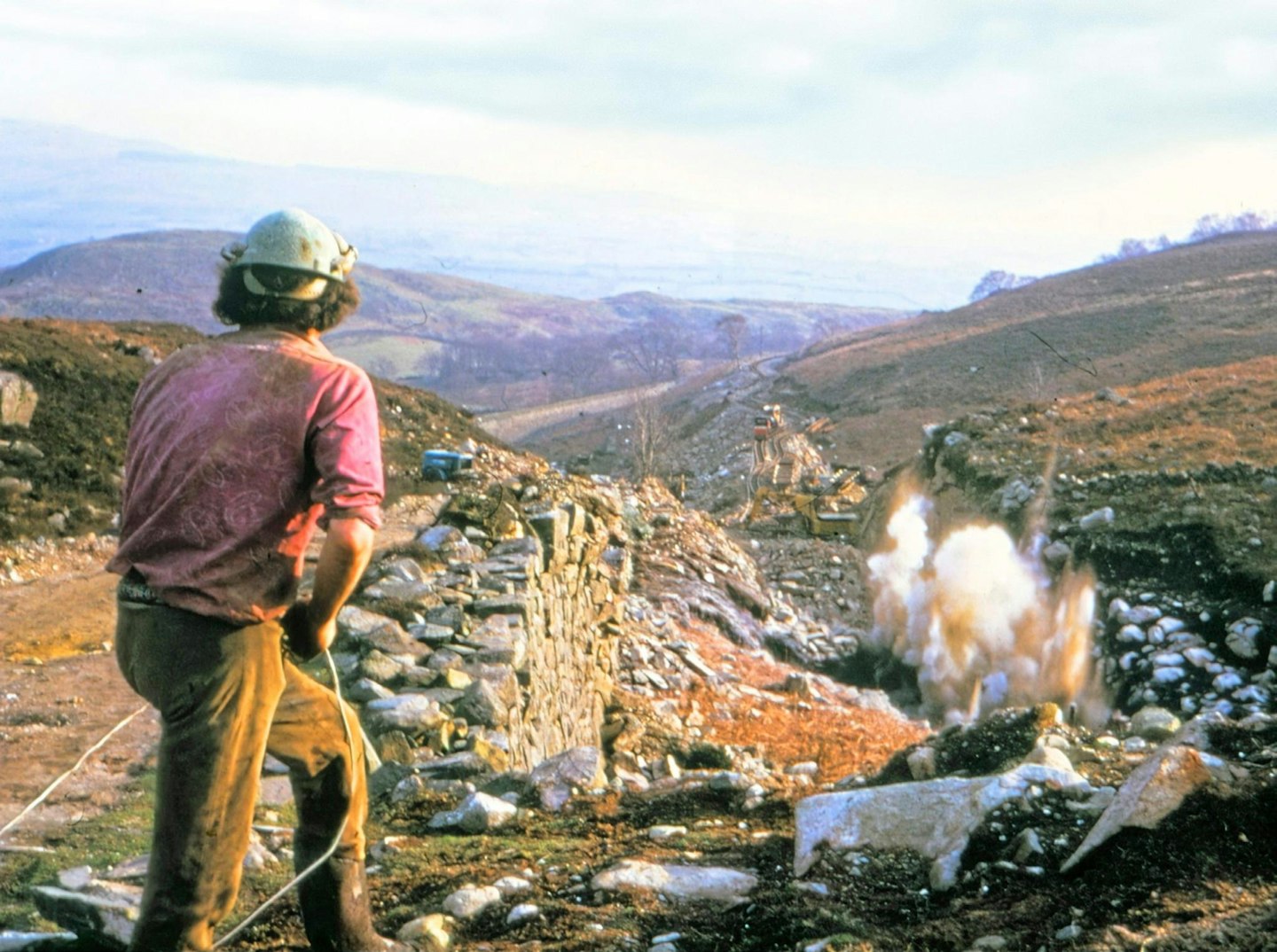
Detonating a charge. Building the New Moelwyn Tunnel relied on traditional mining and excavation techniques. PETER JOHNSON COLLECTION
Breakthrough
I’d spent a couple of summers driving a bigger version of the Atlas Copco loader in nickel and copper mines in Canada, so this generally became my job. Pete and Robin roared in and out with full and empty skips. The track was advanced by using a pair of rails laid on their side, the head clamped into the web of the preceding rail and held with a special Eimco clamp. The loader is a brutal machine with over-width wheels, and can run on flange, tread, or occasionally neither. There are tricks to re-railing it without stopping. There is no rock big enough that it can’t throw it into the truck behind. A skip can be loaded in under a minute. Shunting and track extension takes the other minutes of the hour.
I wrote earlier ‘if nothing went wrong’… We were saving money by hiring very old air compressors from Queens’ Garage in Blaenau, the idea being that Johnny Queens would not be far away to berate if they faltered. In freezing weather, it wasn’t unusual to see Robin standing astride a naked compressor, feeding blazing newspaper, lit by Peter, the smoker in the group, into the air intake. Things would degenerate further as the batteries failed, by having to jump start it from the battery loco. It would eventually start with a roar, when the night’s snow would melt and steam off everything. Then we would find our water supply had frozen in the pipes – a rock drill needs a water feed as well as compressed air.
In this way we progressed. Bunny ran the screening plant, assisted by Dave Payne. He could be seen, or barely seen, enveloped in a massive cloud of black smoke as one of the smaller diesel locos attempted to propel a rake of rock-filled skips up to the tipping chute. We would fill about 50 skips from the blast each morning. If the plant broke down, as it did most days, then dark humour took over! FR staff member Martin Duncan, who welded broken things, and sharpened drill rods, rounded out our complement.
It was during this period that the Blue Peter TV people decided to do a special ‘Go With Noakes’ on the Deviation. A lot of filming was done inside the tunnel – loading, drilling, and blasting – all the stuff that is never seen, even on the internet nowadays. However, not much was actually shown in the grainy video that ended up on screen. Shame!

A wider view of the south portal under construction, with the scaffolding platform in place. PETER JOHNSON COLLECTION
We knew the day when we should break through, so the BBC was booked, and this was the time that Johnny Queens’ compressor really failed us – with two days to go. It wasn’t easy to get a new compressor towed over the hill to site. So, we three miners split into two gangs, with helpers, and achieved four rather smokey blasts in those two days.
I well remember standing on the little platform at Coed y Bleiddiau – I was living down the hill at Bron Turnor at the time. It was 2am, and Norman Gurley (FR permanent way ganger and photographer) was bringing up the battery loco plus about 30 emptied skips with the Simplex, ‘Mary Ann’. I could hear him in the distance, full throttle, and all I could see was an exhaust pipe, red hot, with flames a metre long shooting out the top. We blasted the final round at 11.04am the next day, four minutes late.
We all retired to the Oakley Arms for a celebration. It is recorded that, in former times, a calf was slaughtered and barrels of ale rolled in the door to celebrate the opening of the first tunnel. I remember being miffed that I had to pay for my own sandwiches, but I was given a special commemorative plate to keep.
It took eight months to break through to the north cutting. We then came back and blasted the roof down to full size. To do this, the platform was dispensed with, and we worked off the broken rock pile. Leaving a week’s worth of rock, Robin and Pete carried on drilling each day, whilst I loaded rock at a safe distance behind.
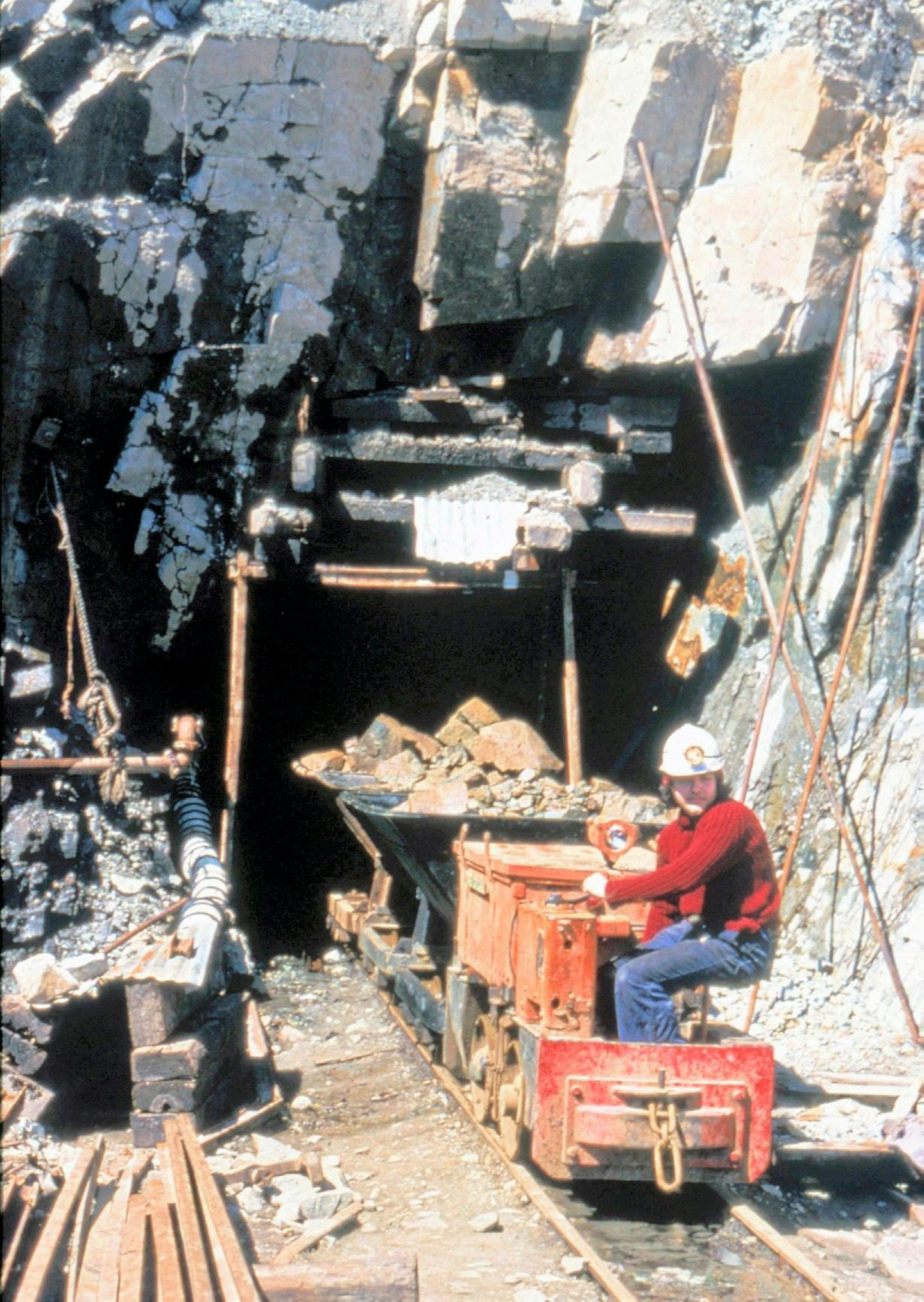
A battery-electric locomotive hauls away some newly blasted stone out from the south portal, ready to be processed and disposed of. PETER JOHNSON COLLECTION
Fond memories
In retrospect they seem happy days, with many stories to tell. I was living in Rhoslyn Cottage at Dduallt station by the end. A lovely place, where I felt I was the one doing the haunting. Gas bottles carried on the shoulder from Dduallt Manor, and glow worms in the ballast late at night after the last train. On a Monday, Robin and Pete would arrive back from Cornwall, with a loaf of bread from the Tanygrisiau bakery, and we would feast on what the weekend volunteers had left behind. This could be a giant catering tin without a label, such as prunes or greengages and, inevitably, cheese. We lived like kings! Except for the day that is, when all we could find was flour, tea bags and cough sweets. There was serious talk of frying the tea bags in batter in the horrible chip pan!
Bunny Lewis was a lovely person, absolutely right for the job of bellowing commands to the girls and boys who appeared each weekend to heave rock, but easy to tease. A trick we played more than once was to hide in one of the many rock-filled trucks up by the screening plant, then let the brake off. The rake of trucks then started down the spiral to meet the service train at Dduallt. As Bunny set off down the old track from the Tunnel Mess with giant strides, a head would appear up from the first truck and apply the brake. It was a mean trick to play, especially the second time.
With the screening plant not working as planned, most of the rock produced from the tunnel was just dumped – mainly on the inside of the curve that leads away from Dduallt station towards the spiral. Some was disposed of before then at, I think, Dragon Site, where the new formation is directly above the old formation.

The opening ceremony of the New Moelwyn Tunnel south portal on October 10 2021, marking the final completion of the tunnel 46 years after construction first got under way. Compare this view to that of the same location on p85 – much has changed in the intervening four decades! CHRIS PARRY/FFWHR
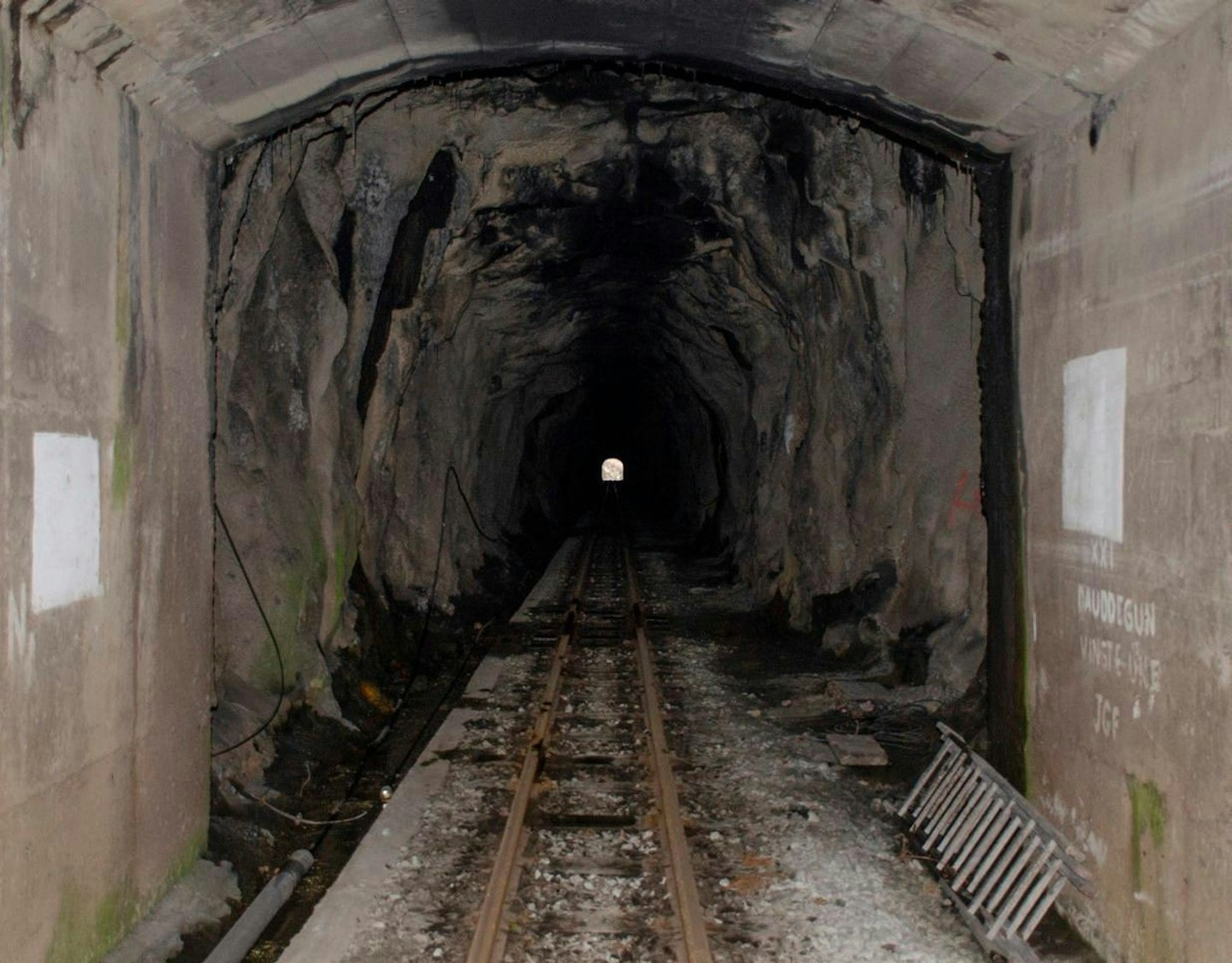
I learnt a lesson one freezing morning, not having tipped the skips the evening before, as I backed the rake along a temporary siding and the first skip was tipped. The rock had frozen inside and the whole wagon went over and down, pulling off the next. I watched in horror as one after another they peeled off and went down. I jumped off the loco as that too went over. A day was spent dragging them all back onto the rails on the old formation below.
But it wasn’t all bad. Norman Gurley was the quiet one amongst us all, the opposite to Bunny! He would quietly sort things, be in charge of the temporary track at the Dduallt dumping site, take the BEV mine loco back to Tan y Bwlch each night for charging, erect new fencing during the day – only for a local farmer, vehemently opposed to the reopening of the FR, to tear it out again during the night!
It wasn’t safe for casual visitors to enter the tunnel as it progressed. Danger lurked everywhere, with the rough track, loco movements, the roar of rock drills, and blasting. One person walked past us as we were hiding behind a rock ready to blast. On shouting at him, he remarked that it was OK, he was a member of the Society, and carried on towards the tunnel mouth. Only a couple of words followed! Another time, two enterprising girls decided we needed a tray of mugs of tea towards the end of the drilling stage each afternoon, at the rock face. They rapidly won our acceptance of this, and as a result Sue married Robin, who lived happily ever after, so I’m told.
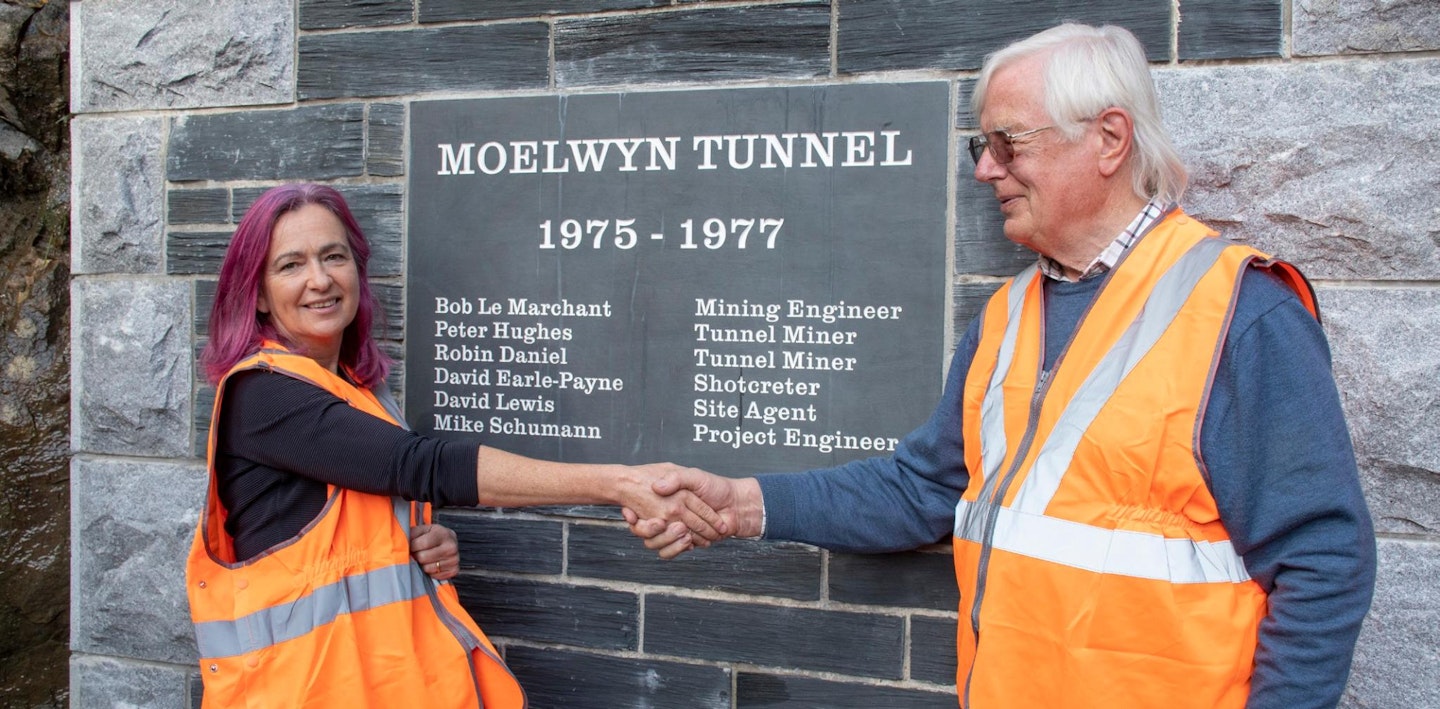
Liz Saville-Roberts MP shakes hands with Moelwyn Tunnel Project Engineer Mike Schumann during the south portal opening ceremony on October 10 2021. CHRIS PARRY/FFWHR
The final act for us three was to trim intrusive bits of rock in the tunnel to clear the profile gauge. Rock bolts two metres long, and 668 in number, were drilled into the roof using a mobile stage, and resin-grouted into place. Then heavy wire netting was fastened across the crown of the tunnel with Hilti bolts.
The application of Shotcreting by the company is whole other story, not involving the three of us. Peter went back to South Crofty mine and became their Chief Safety Officer. Robin and Sue went back to Cornwall and established their own company, which operated mines in Ireland, tunnelled everywhere and generally carried out anything to do with rock. I left to open up an underground tourist railway at Morwellham Quay Museum in Devon.
Due to financial constraints, and a seemingly never-ending series of more important civil engineering works, the ornamental portals planned for each end of the new tunnel weren’t built until the original utilitarian concrete portals had deteriorated to the point where remedial action became necessary – in 2019 for the northern portal and 2021, for the southern. A suitably inscribed commemorative plaque was installed at the southern portal.
